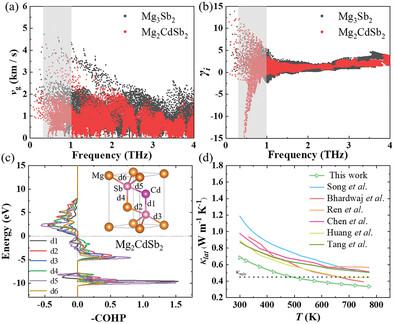Our official English website, www.x-mol.net, welcomes your
feedback! (Note: you will need to create a separate account there.)
Breaking the Minimum Limit of Thermal Conductivity of Mg3Sb2 Thermoelectric Mediated by Chemical Alloying Induced Lattice Instability
Small ( IF 13.0 ) Pub Date : 2023-04-22 , DOI: 10.1002/smll.202301382 Jinsuo Hu 1 , Jianbo Zhu 1 , Xingyan Dong 1 , Muchun Guo 1 , Yuxin Sun 1 , Wenjing Shi 1 , Yuke Zhu 1 , Hao Wu 1 , Fengkai Guo 1 , Yi-Xin Zhang 2 , Zhen-Hua Ge 2 , Qian Zhang 3 , Zihang Liu 1 , Wei Cai 1 , Jiehe Sui 1
Small ( IF 13.0 ) Pub Date : 2023-04-22 , DOI: 10.1002/smll.202301382 Jinsuo Hu 1 , Jianbo Zhu 1 , Xingyan Dong 1 , Muchun Guo 1 , Yuxin Sun 1 , Wenjing Shi 1 , Yuke Zhu 1 , Hao Wu 1 , Fengkai Guo 1 , Yi-Xin Zhang 2 , Zhen-Hua Ge 2 , Qian Zhang 3 , Zihang Liu 1 , Wei Cai 1 , Jiehe Sui 1
Affiliation

|
Thermal properties strongly affect the applications of functional materials, such as thermal management, thermal barrier coatings, and thermoelectrics. Thermoelectric (TE) materials must have a low lattice thermal conductivity to maintain a temperature gradient to generate the voltage. Traditional strategies for minimizing the lattice thermal conductivity mainly rely on introduced multiscale defects to suppress the propagation of phonons. Here, the origin of the anomalously low lattice thermal conductivity is uncovered in Cd-alloyed Mg3Sb2 Zintl compounds through complementary bonding analysis. First, the weakened chemical bonds and the lattice instability induced by the antibonding states of 5p-4d levels between Sb and Cd triggered giant anharmonicity and consequently increased the phonon scattering. Moreover, the bond heterogeneity also augmented Umklapp phonon scatterings. Second, the weakened bonds and heavy element alloying softened the phonon mode and significantly decreased the group velocity. Thus, an ultralow lattice thermal conductivity of ≈0.33 W m−1 K−1 at 773 K is obtained, which is even lower than the predicated minimum value. Eventually, Na0.01Mg1.7Cd1.25Sb2 displays a high ZT of ≈0.76 at 773 K, competitive with most of the reported values. Based on the complementary bonding analysis, the work provides new means to control thermal transport properties through balancing the lattice stability and instability.
中文翻译:

化学合金化引起的晶格不稳定性打破了Mg3Sb2热电热导率的下限
热性能强烈影响功能材料的应用,例如热管理、热障涂层和热电材料。热电 (TE) 材料必须具有低晶格热导率,以维持温度梯度以产生电压。最小化晶格热导率的传统策略主要依靠引入多尺度缺陷来抑制声子的传播。在这里,通过互补键合分析揭示了 Cd 合金 Mg 3 Sb 2 Zintl 化合物中异常低晶格热导率的根源。首先,Sb和Cd之间5p-4d能级反键态引起的化学键减弱和晶格不稳定性引发了巨大的非谐性,从而增加了声子散射。此外,键的异质性也增强了 Umklapp 声子散射。其次,弱化的键和重元素合金化软化了声子模式并显着降低了群速度。因此,在773 K时获得了约0.33 W m -1 K -1的超低晶格热导率,这甚至低于预测的最小值。最终,Na 0.01 Mg 1.7 Cd 1.25 Sb 2在773 K 时表现出约0.76 的高ZT,与大多数报道的值具有竞争力。基于互补键合分析,该工作提供了通过平衡晶格稳定性和不稳定性来控制热传输性能的新方法。
更新日期:2023-04-22
中文翻译:

化学合金化引起的晶格不稳定性打破了Mg3Sb2热电热导率的下限
热性能强烈影响功能材料的应用,例如热管理、热障涂层和热电材料。热电 (TE) 材料必须具有低晶格热导率,以维持温度梯度以产生电压。最小化晶格热导率的传统策略主要依靠引入多尺度缺陷来抑制声子的传播。在这里,通过互补键合分析揭示了 Cd 合金 Mg 3 Sb 2 Zintl 化合物中异常低晶格热导率的根源。首先,Sb和Cd之间5p-4d能级反键态引起的化学键减弱和晶格不稳定性引发了巨大的非谐性,从而增加了声子散射。此外,键的异质性也增强了 Umklapp 声子散射。其次,弱化的键和重元素合金化软化了声子模式并显着降低了群速度。因此,在773 K时获得了约0.33 W m -1 K -1的超低晶格热导率,这甚至低于预测的最小值。最终,Na 0.01 Mg 1.7 Cd 1.25 Sb 2在773 K 时表现出约0.76 的高ZT,与大多数报道的值具有竞争力。基于互补键合分析,该工作提供了通过平衡晶格稳定性和不稳定性来控制热传输性能的新方法。






























 京公网安备 11010802027423号
京公网安备 11010802027423号